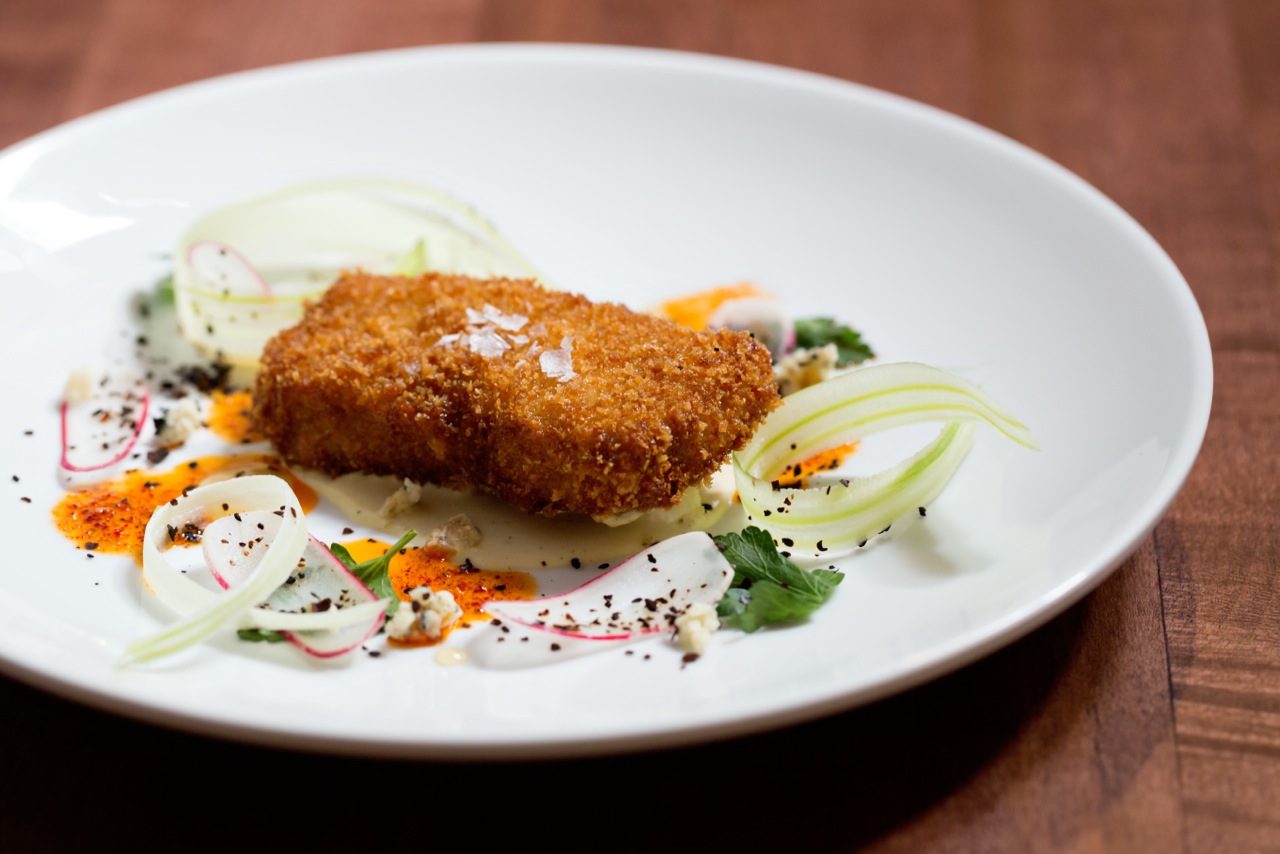Anatomy of Alden & Harlow’s Chicken Fried Rabbit

Chef Michael Scelfo’s chicken fried rabbit at Alden & Harlow. Photo provided
Alden & Harlow’s Michael Scelfo said his “jaw hit the floor” when Bon Appetit bestowed a Best New Restaurant nomination on his fledgling Harvard Square restaurant last week. One of the standout dishes mentioned in restaurant editor Andrew Knowlton’s ultimate verdict? The chicken fried rabbit with blue cheese and chili oil, a not-so-surprising choice, despite Alden & Harlow’s reputation for vegetable-driven small plates.
On a menu that changes faster than the seasons, this fried nugget of coarsely ground hare has remained firmly entrenched, a buzzed-over dish now receiving as much attention as Scelfo’s cultish “Secret Burger.” Scelfo offers several reasons why he’s been reluctant to swap out this forcemeat of rabbit and pork belly fat—notably that it’s one of the few dishes on Alden & Harlow’s menu to actually utilize his kitchen’s fryers. But this deceptively simple concept—an ode the hearty, gravy-laden fare of the Midwest—strikes a much more personal note with Scelfo.
“I grew up in the Midwest—Kansas City in particular—and chicken fried steak was the thing to eat there,” Scelfo says. “I loved everything about it: the crispy, fried exterior, the creamy béchamel gravy, and the biscuits that came on the side. Those kind of flavors and that style of cooking ended up working its way onto the menu because I love to explore the foods that I grew up with. Overall, I think it’s a really good example of the type of food we do here. It might look simple at first glance, but there’s a lot of legwork and a lot of prep that goes into it.”
Instead of using a beef bottom cutlet or pounded-out cube steak, Scelfo opted to use local rabbit from Feather Brook Farm in Raynham, an ingredient Scelfo admits to having a “love/hate” relationship with. “Like many chefs, I love it personally and whenever I see rabbit on a menu, I always order it,” Scelfo says. “I love breaking them down and working with them, but they’re sometimes a hard sell, even at nicer restaurants. So, I knew I had to make it approachable for the guests.”
In his first rough draft of Alden & Harlow’s menu, printed before he had even opened its doors, you can see a variation of Scelfo’s rabbit entree. But the original version—served with kimchi, honeydew, and Thai basil—would evolve into a much different dish by the time it made its first public appearance in January 2014.
“That dish was literally conceived in a text exchange with my sous chef Dave [Tollerud],” Scelfo says. “We just went back and forth until we had something we could agree on. When we finally hit upon the components that are in it now, I said, ‘that’s it!’ I just knew it would work. Mind you, this was before we had even tried to make it in the kitchen.”
We asked Scelfo to give us a breakdown of his chicken fried rabbit. Here, in his own words, are the ingredients and the influences behind each one.
1. Rabbit
“For the rabbit itself we decided to make a forcemeat and treat it like a pâté. It’s a very lean animal so we needed to get some fat in there. We chose pork, in the form of belly, and made a 70 to 30 blend. It’s 70 percent rabbit and 30 percent belly. I think 30 percent is where you want the fat to be at in terrines and pâtés. I try to stay pretty true to that; I even do that with my burger grind.
Next, we take a traditional mirepoix of carrot, onion, and celery, and sweat it down with fresh thyme, bay leaf, and celery seed. To me, celery seed is one of the most crucial aspects to the whole thing. When making barbecue dry rubs, I try to duplicate the flavor of the Kansas City spots I really love like Gates Bar B.Q., and that requires using celery seed. So, it’s one of the more dominant flavors in the forcemeat itself. I fold that aromatic mix into the ground combination [of pork belly and rabbit] and mold it using a meat glue. Instead of putting egg, bread, flour, and all this gunk that takes away from the protein itself, we actually use a slurry of meat glue and bind it together, shape it in Pullman bread loaf pans, and then slice it into little bricks. Afterward, we deep each slice in buttermilk, roll it in panko bread crumbs, and fry it until crispy.”
2. Blue Cheese Dressing
“Instead of serving a cream gravy, we made a cream sauce using some really, really, nice blue cheese. It’s Bayley Hazen Blue from Jasper Hill Farm in Vermont, which we buy from Formaggio Kitchen. You probably shouldn’t make a blue cheese dressing out of a cheese that good, but we decided to go for it anyway.”
3. Honey Apple Sauce
“After eating through it the first time, we decided it needed something sweet. So, we made an apple reduction by cooking down Gala apples with apple cider and honey.”
4. Raw Accompaniments
“We decided to keep the accompaniments fairly simple because that nugget of goodness is so fried and dense and the sauce is so rich. We needed everything else on the plate to help cut through that. So we shave some raw radish and raw celery and plate that along with some parsley leaves and crushed Urfa pepper. The finished dish looks very crisp and fresh and light; sort of like what you would feed a rabbit if you had one as a pet, which I think is pretty funny. It needed some heat though, so we added the Urfa pepper, which ended up being a nice garnish. It has a very raisiny, dried fruit quality that also brings heat to the dish. I also think it gives the plate a really cool look, almost like soil sprinkled over the vegetables, which made sense from an aesthetic point of view.”
5. Chili Oil
“Besides some more blue cheese crumbles, we also drizzle on a chili oil that we’ve been making in-house since day one. We just took all the chilies and spices we could find in the restaurant and made a really deep, fragrant oil that serves as a nice contrast on the plate. It’s predominantly Sichuan peppercorn, Korean chili flake, sumac, aleppo, as well as a few other ‘secret’ things.”
40 Brattle St., Cambridge; 617-864-2100 or aldenharlow.com.


